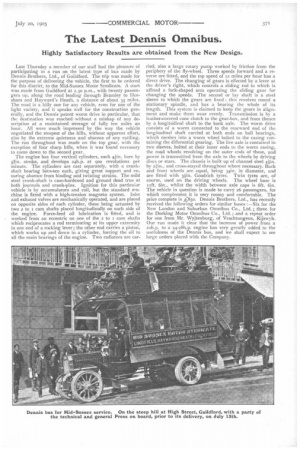The Latest Dennis Omnibus.
Page 7

If you've noticed an error in this article please click here to report it so we can fix it.
Highly Satisfactory Results are obtained from the New Design.
Last Thursday a member of our staff had the pleasure of participating in a run on the latest type of bus made by Dennis Brothers, Ltd., of Guildford. The trip was made for the purpose of delivering the vehicle, the first to be ordered for this district, to the Mid-Sussex Motor Syndicate. A start was made from Guildford at 2.30 p.m., with twenty passengers up, along the road leading through Bramley to Horsham and Hayward's Heath, a distance of about 35 miles. Theroad is a hilly one for any vehicle, even for one of the light variety, and it speaks well for the construction generally, and the Dennis patent worm drive in particular, that the destination was reached without a mishap of any description at a maintained average of fully ten miles an hour. MI were much impressed by the way the vehicle negotiated the steepest of the hills, without apparent effort, also by the extreme quietness and absence of any rattling. The run throughout was made on the top gear, with the exception of four sharp hills, when it was found necessary to come down to the second gear.
The engine has four vertical cylinders, each bore by 5fin. stroke, and develops 24h.p. at goo revolutions per minute. The cylinders are cast separately, with a crankshaft bearing between each, giving great support and ensuring absence from binding and twisting strains. The mild steel crank-shaft is case-hardened and ground dead true at both journals and crank-pins. Ignition for this particular vehicle is by accumulators and coil, but the standard machine is fitted with a high-tension magneto system. Inlet and exhaust valves are mechanically operated, and are placed on opposite sides of each cylinder, these being actuated by two 2 to i cam shafts placed longitudinally on each side of the engine. Force-feed oil lubrication is fitted, and is worked from an eccentric on one of the a to I cam shafts which reciprocates a rod terminating at its upper extremity in one end of a rocking lever; the other end carries a piston, which works up and down in a cylinder, forcing the oil to all the main bearings of the engine. Two radiators are car ried, also a large rotary pump worked by friction from the periphery of the fly-wheel. Three speeds forward and a reverse are fitted, and the top speed of 12 miles per hour has a direct drive. The changing of gears is effected by a lever at the driver's right, which controls a sliding rod to which is affixed a fork-shaped arm operating the sliding gear for changing the speeds. The second or lay shaft is a steel sleeve to which the gears are fixed : this revolves round a stationary spindle, and has a bearing the whole of its length. This system is claimed to keep the gears in alignment and make them wear evenly. Transmission is by a leather-covered cone clutch to the gear-box, and from thence by a longitudinal shaft to the back axle. The worm drive consists of a worm connected to the rearward end of the longitudinal shaft carried at both ends on ball bearings, which meshes into a worm wheel bolted to the casing containing the differential gearing. The live axle is contained in two sleeves, bolted at their inner ends to the worm easing, the road wheels revolving on the outer ends of these, and power is transmitted from the axle to the wheels by driving discs or stars. The chassis is built up of channel steel 4iin. by 21in., and cross-stayed throughout where necessary. Back and front wheels are equal, being 34in. in diameter, and are fitted with Goodrich tyres. Twin tyres are, of course, used on the driving wheels. The wheel base is Ilft. 6in., whilst the width between axle caps is 61t. 6in. The vehicle in question is made to carry 26 passengers, for which complement it is very roomy and comfortable. The price complete is Disc). Dennis Brothers, Ltd., has recently received the following orders for similar buses :—Six for the New London and Suburban Omnibus Co., Ltd. ; three for the Dorking Motor Omnibus Co., Ltd. ; and a repeat order for one from Mr. Wyjtenburg, of Vrachtungeus, Rijswyh. Our run made it clear that the increase of power from a 20h.p. to a 24-28h.p. engine has very greatly added to the usefulness of the Dennis bus, and we shall expect to see large orders placed with the Company.


















